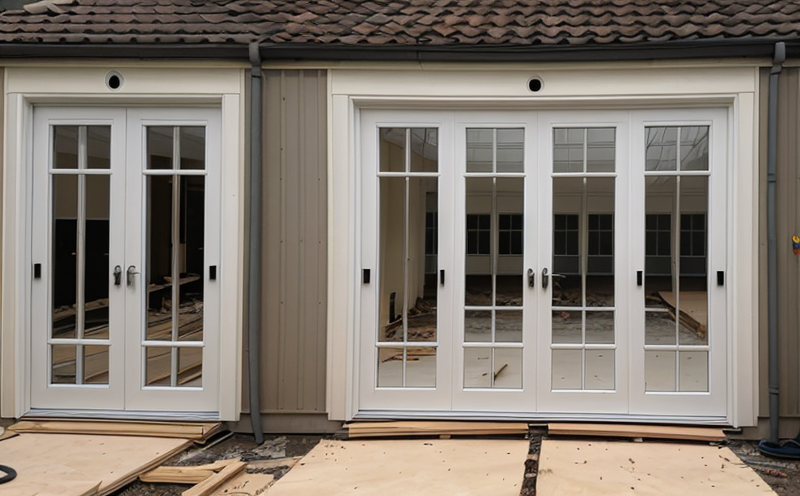Fire Endurance Testing of Timber Doors
Fire endurance testing of timber doors is a critical process in ensuring that building materials meet stringent fire safety standards. This testing evaluates the ability of timber doors to resist fire for a specified period, maintaining structural integrity and preventing the spread of fire. The performance criteria encompass both thermal insulation and load-bearing capabilities under exposure to high temperatures and flames.
The primary goal is to ensure that when used in buildings, these doors can provide sufficient protection against the spread of fire, allowing occupants time to evacuate safely or to maintain a safe environment for firefighters. This testing is particularly important given the increasing complexity of modern building designs and the potential for faster, more intense fires due to factors such as climate change and urbanization.
Fire endurance tests are conducted in accordance with international standards such as ISO 14693:2018, which specifies the requirements for fire resistance testing of doors. These standards provide detailed protocols on how to prepare samples, set up test conditions, monitor performance, and interpret results.
Before undergoing testing, timber doors are carefully prepared by adhering to specific guidelines laid out in the relevant standards. This includes ensuring that the door is free from defects, ensuring proper fitting of hardware, and maintaining consistent thickness throughout the specimen. The testing procedure involves exposing the door to controlled conditions of heat and flame for a specified duration, with continuous monitoring of temperature rise on both sides.
The test apparatus typically consists of a furnace capable of generating temperatures up to 1000°C, along with specialized sensors to measure temperature changes across the door. The fire resistance time is determined based on visual inspection and thermal integrity checks. Visual inspection involves checking for signs of structural collapse or flame penetration through the door. Thermal integrity is assessed by measuring heat flow through the specimen using thermocouples placed at strategic locations.
Once testing is complete, detailed reports are generated summarizing all aspects of the test, including the duration of fire resistance and any visual observations made during the experiment. These reports serve as crucial documentation for compliance with building codes and regulations in various jurisdictions around the world.
The results from these tests play a vital role in determining whether timber doors can be used in specific applications within buildings that require stringent fire safety measures. By adhering to rigorous testing protocols, manufacturers ensure their products meet or exceed required standards, thereby enhancing public safety and confidence in construction practices.
International Acceptance and Recognition
- ISO 14693:2018 – International Standard for Fire Resistance Testing of Doors
- ASTM E119-21 – American Society for Testing and Materials Standard for Fire Tests of Building Materials
- EN 1634-1:2008 – European Norm for Doorsets with Glass in Fire Resistance Tests
The fire endurance testing of timber doors is widely recognized across various countries and regions, ensuring consistent quality standards. The aforementioned international standards ensure that the testing process adheres to globally accepted protocols, which are essential for cross-border trade and cooperation.
Adherence to these standards provides a level playing field for manufacturers who export their products internationally. It also facilitates easier compliance with local regulations in different countries by providing standardized methods for evaluating fire resistance properties of doors. This recognition enhances the reputation of tested products among buyers worldwide, fostering trust and confidence in the market.
Environmental and Sustainability Contributions
The use of timber doors during fire endurance testing also contributes positively to environmental sustainability efforts. Timber sourced from managed forests is a renewable resource, which reduces reliance on non-renewable materials like steel or concrete. Additionally, the production process associated with manufacturing timber doors generates fewer greenhouse gas emissions compared to other construction materials.
Furthermore, incorporating fire-resistant properties into timber through proper treatment and design can significantly reduce the overall environmental impact of building fires. This includes minimizing damage to surrounding structures and reducing the need for extensive repairs or replacements post-disaster. By enhancing fire resistance capabilities in timber doors, architects and builders can contribute towards more sustainable urban development practices.
Competitive Advantage and Market Impact
Implementing robust fire endurance testing for timber doors offers several competitive advantages that can enhance market positioning. Firstly, meeting strict safety standards positions a manufacturer favorably in the eyes of regulatory bodies and consumers alike. This aligns with growing global demand for safer buildings and structures capable of withstanding harsh environmental conditions.
Secondly, successful completion of rigorous fire tests demonstrates commitment to quality control processes, setting benchmarks within the industry. Such achievements resonate well with stakeholders seeking reliability and innovation in their procurement decisions. Consequently, this can lead to increased customer trust and loyalty over time, translating into higher sales volumes and broader market penetration.
Lastly, compliance with international standards opens up new opportunities for exporting goods internationally, given harmonized requirements across borders. This expansion into global markets not only broadens geographical reach but also strengthens brand identity as a leader in sustainable construction solutions.





